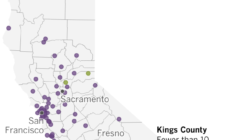-
Trump Asks Supreme Court to Halt Sentencing in N.Y. Hush-Money Case - 7 mins ago
-
99-mph winds bring night of terror as fires rock SoCal communities - 28 mins ago
-
Dad Receives Cake for 54th Birthday, Internet Can’t Cope With What It Shows - 29 mins ago
-
Ukraine Strikes Oil Depot Near Russian Air Base, Ukrainian Military Says - 51 mins ago
-
Trump Warned Against Invading Greenland by France—’Sovereign Borders’ - about 1 hour ago
-
Wildfires in Southern California – The New York Times - 2 hours ago
-
How Horse Acts When She Sees Owner Melts Hearts - 2 hours ago
-
FDA announces limits on toxic lead in baby foods - 2 hours ago
-
Russians Mourn Two Elite Colonels Killed in Storm Shadow strike on army HQ - 2 hours ago
-
Italy Says Cecilia Sala, Journalist Detained by Iran, Has Been Released - 2 hours ago
The World’s Fifth-Largest Economy is About to Ban Most Polystyrene Foam
California, the most populous U.S. state and fifth-largest world economy, will effectively ban the use of most expanded plastic foam food containers on January 1, a move conservationists called a major development in the effort to limit plastic waste.
“We found that this could eliminate up to 3.9 billion pieces of foam ware every single year,” Anja Brandon, director of plastics policy at the environmental nonprofit Ocean Conservancy, told Newsweek.
Clamshell containers, cups and other food ware items made from expanded polystyrene foam are popularly—though incorrectly—called Styrofoam, which is a registered brand name for styrene foam construction materials made by DuPont. But whatever you call it, Brandon said, foam ware makes a remarkable mess when it all too often ends up as litter.

Frederic J. Brown/AFP via Getty Images
“These cups and clam shells break apart into a bunch of little pieces, just creating microplastics everywhere,” Brandon said. “It’s lightweight, it can travel incredibly long distances, and there are much better reusable or recyclable options to replace it with.”
Brandon added that there are few options for recycling polystyrene foam ware. The U.S. Environmental Protection Agency estimates that less than 1 percent gets recycled.
California’s 2022 law on plastic waste, the Plastic Pollution Prevention and Packaging Producer Responsibility Act, more commonly called SB 54, set ambitious goals for recycling on many types of plastics. Starting Wednesday, users of polystyrene foam ware in California are required to show that at least 25 percent of the products are recycled or stop using them, a de facto ban given the paltry rate of recycling for plastic foam ware.
The law also set up an extended producer responsibility system to help pay for improvements in waste collection, sorting and recycling. The law set targets within a decade to reduce single-use plastics by 25 percent and ensure that all plastic food ware is either recyclable or compostable.
California’s Department of Resource Recycling and Recovery will gather data on recycling rates for foam ware, but Brandon said it is highly unlikely any companies will meet the 25 percent threshold.
One of the larger producers of expanded foam ware, Dart Container, said the company is “adapting to an evolving regulatory environment” but will not be doing as much business in California.
“While the recent legislation has required us to make the difficult decision to reduce the size of our workforce and operations within the state, Dart remains dedicated to serving our customers by continually innovating and delivering sustainable, reliable, and affordable products,” Dart Container CEO Keith Clark told Newsweek via email. “We are actively realigning our resources to position Dart to meet the changing needs of our industry and customers.”
At a Newsweek Horizons event earlier this month on plastic waste, panelists highlighted the importance of action on products such as expanded polystyrene foam that do not have a clear path to sustainable reuse or recycling.
“You want to get rid of the things that are the most problematic and harmful in the first place,” Erin Simon, the World Wildlife Fund vice president and head of Plastic Waste and Business, said at the December 4 event, “The Future of Plastics.”
Panelist Jonathan Quinn, CEO of the U.S. Plastics Pact, said that the more than 100 companies and organizations in the pact have developed a policy road map for sustainable plastics, including a list of problematic materials such as expanded polystyrene.
“One of the key targets of that road map is to eliminate those materials,” Quinn said.
The United Nations is leading ongoing negotiations for a global treaty on plastic waste, and Quinn said there is “strong alignment” between language in the treaty and the pact’s list of problematic materials. The last talks on the treaty ended December 1 without consensus agreement among the party nations and the UN has indicated it will schedule another round of negotiations in 2025.
In the meantime, state action such as the California law will likely be the main driver of efforts to limit plastic waste. Ten other states and more than 100 cities have also banned or sharply limited foam ware, but because of its size, the California law is expected to have a greater effect, Brandon said, accelerating the industry shift to more sustainable alternatives.
“The businesses themselves are recognizing that there are some material types that are just more problematic and unnecessary,” she said.
The Ocean Conservancy organizes one of the largest beach litter removal events in the world, the international coastal cleanup, Brandon said, and data from the accumulated waste is revealing.
She said that even though expanded foam makes up a tiny portion of the total plastics we use, it is among the top 10 waste items collected in the coastal cleanup.
After Maryland became the first state to pass this type of ban, Brandon said, Ocean Conservancy was able to compare the cleanup results before and after the ban went into effect.
“The amount of plastic foam ware items collected by our international coastal cleanup volunteers declined by 65 percent,” Brandon said. “So this really does show that these types of policies work when it comes to preventing ocean plastic pollution.”
Source link




















